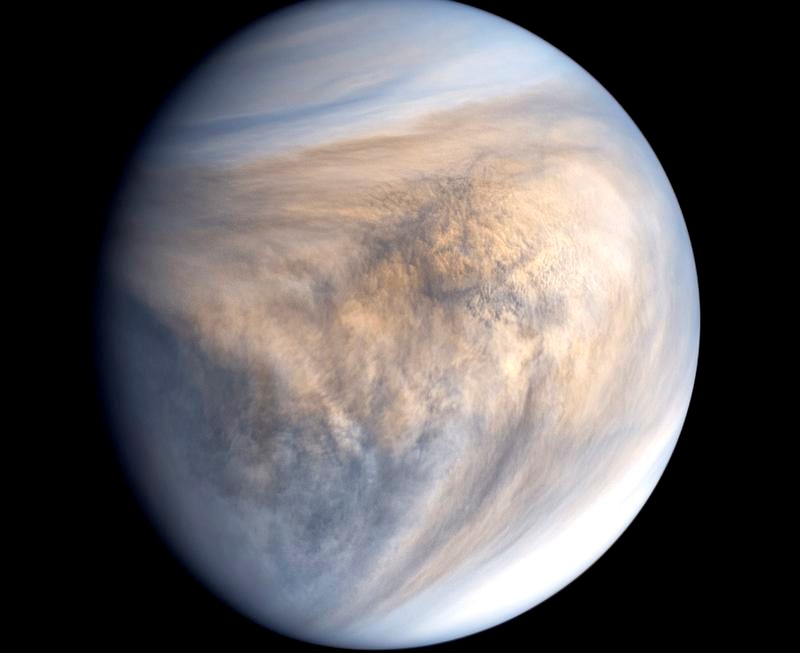Description

Source: Hindu
Disclaimer: Copyright infringement not intended.
Context
- Venus, the second planet from the Sun, presents a significant anomaly with its extreme dryness compared to Earth.
- While scientists have accounted for much of Venus's water loss over billions of years, some of it remains unaccounted for.
- A recent discovery involving a chemical reaction might bridge this gap and offer insights into the planet's past water content and its implications for planetary habitability.
Details
Historical Water Content
- More than four billion years ago, Venus had enough water to form an ocean 3 kilometers deep.
- Today, this volume has diminished to just 3 centimeters, signifying a drastic reduction in water content over time.
Reasons for Water Loss
- Atmospheric Conditions
- Greenhouse Effect:Venus’s carbon dioxide-rich atmosphere creates a severe greenhouse effect, raising surface temperatures to 450°C (842°F), above water’s boiling point.
- Vaporization:Water can only exist as vapor in Venus's atmosphere under these conditions.
- Solar Proximity
- UV Radiation:The Sun's ultraviolet radiation breaks water molecules into hydrogen and oxygen atoms in Venus’s ionosphere.
Mechanisms of Water Loss
Two primary processes contribute to the water loss:
- Thermal Process (Hydrodynamic Escape): In the planet’s early history, the Sun heated Venus's outer atmosphere, causing it to expand and allowing hydrogen to escape into space. This process likely ceased around 2.5 billion years ago as the atmosphere cooled.
- Non-Thermal Process (Hydrogen Escape): Eryn Cangi and her colleagues focused on current water loss via hydrogen escape. This non-thermal process, previously underestimated, involves a chemical reaction that significantly accelerates water decline.
Key Findings
- Formyl Cation (HCO+):This molecule, identified in Mars's atmosphere as facilitating hydrogen escape, is now believed to play a similar role on Venus.
- HCO+ Dissociative Recombination Reaction (DR):This reaction, occurring at about 125 km altitude, involves HCO+ breaking down into carbon monoxide and a hydrogen atom. The energetic hydrogen atoms then escape into space.
- Doubling of Water Loss Rate:Modeling this reaction suggests it could double the rate of hydrogen escape, implying Venus lost water faster and could have maintained oceans longer than previously thought.
- Remaining Water:Despite these processes, some water persists on Venus, possibly replenished by comet impacts.
About Venus
Basic Facts:
- Order from Sun:2nd planet
- Type:Terrestrial planet
- Diameter:12,104 km (7,521 miles)
- Mass:867 × 10^24 kg (0.815 Earth masses)
- Orbital Period:7 Earth days
- Rotation Period:243 Earth days (retrograde)
- Its average distance from the Sun is about 108 million km.
- Venus's Day Length:A day on Venus is longer than its year.
- Visibility:Venus is the third-brightest natural object in the sky after the Sun and the Moon.
- Twin Planet:Often called Earth's "sister planet" due to their similar size, mass, and proximity to the Sun, though their conditions are vastly different.

Physical Characteristics:
Atmosphere
- Composition:Primarily carbon dioxide (96.5%), nitrogen (3.5%), with trace amounts of sulfur dioxide, argon, water vapor, carbon monoxide, helium, and neon.
- Pressure:About 92 times Earth's atmospheric pressure at the surface.
- Clouds:Thick clouds of sulfuric acid cover the planet, obscuring its surface.
Surface
- Temperature:Average surface temperature is around 467°C, hotter than Mercury despite being further from the Sun.
- Topography:Features include vast plains, highland regions, and mountain ranges.
- Volcanoes:Venus has more volcanoes than any other planet in the solar system, with significant volcanic activity shaping its surface.
Geological Features
- Maxwell Montes:The highest mountain on Venus, located in Ishtar Terra.
- Tesserae:Complex, ridged, and highly deformed regions.
- Impact Craters:Relatively few due to the planet's young surface, constantly reshaped by volcanic activity.
Orbital and Rotational Dynamics:
Orbit
- Eccentricity:Very low, making Venus’s orbit nearly circular.
- Inclination:Venus's orbit is inclined by about 3.4 degrees to the plane of the Solar System.
Rotation
- Retrograde Rotation:Venus rotates in the opposite direction to most planets in the Solar System.
- Solar Day:One day on Venus (one complete rotation on its axis) takes about 117 Earth days, due to its slow and retrograde rotation.
Exploration:
Early Observations
- Ancient Observations:Known to ancient civilizations and often referred to as the "Morning Star" and "Evening Star".
- Galileo Galilei:First observed phases of Venus through a telescope in 1610, providing evidence for the heliocentric model.
Space Missions
- Mariner 2:The first successful mission to another planet, which flew by Venus in 1962.
- Venera Program:A series of Soviet missions; Venera 7 was the first to land on Venus and transmit data back to Earth in 1970.
- Magellan:A NASA mission that mapped Venus's surface using radar between 1990 and 1994.
- Akatsuki:A Japanese mission currently studying Venus’s atmosphere.
Future Missions
- VERITAS (NASA):Planned to map the surface of Venus with high-resolution radar.
- DAVINCI+ (NASA):Aimed to analyze the composition of Venus’s atmosphere and surface.
Venus in Culture:
- Roman Mythology:Named after Venus, the Roman goddess of love and beauty.
- Greek Mythology:Known as Aphrodite.
Sources:
Hindu
|
PRACTICE QUESTION
Q. Consider the following statements about Venus:
1. Venus has a thick atmosphere primarily composed of carbon dioxide.
2. Venus rotates on its axis from east to west, opposite to most planets in the Solar System.
3. The surface temperature of Venus is lower than that of Mercury, despite being farther from the Sun.
Which of the above statements is/are correct?
A. 1 only
B. 1 and 2 only
C. 2 and 3 only
D. 1, 2, and 3
Answer: B.
|
















